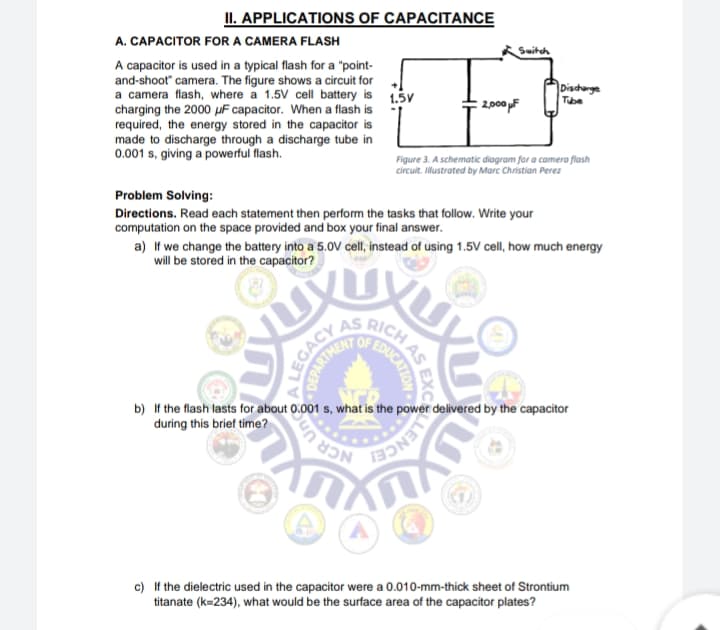If we change the battery into a 5.0V cell, instead of using 1.5V cell, how much energy will be stored in the capacitor? b) If the flash lasts for about 0.001 s, what is the power delivered by the capacitor duringthis brief time? c) If the dielectric used in the capacitor were a 0.010-mm-thick sheet of Strontium titanate (k=234), what would be the surface area of the capacitor plates?
If we change the battery into a 5.0V cell, instead of using 1.5V cell, how much energy will be stored in the capacitor? b) If the flash lasts for about 0.001 s, what is the power delivered by the capacitor duringthis brief time? c) If the dielectric used in the capacitor were a 0.010-mm-thick sheet of Strontium titanate (k=234), what would be the surface area of the capacitor plates?
Physics for Scientists and Engineers, Technology Update (No access codes included)
9th Edition
ISBN:9781305116399
Author:Raymond A. Serway, John W. Jewett
Publisher:Raymond A. Serway, John W. Jewett
Chapter26: Capacitance And Dielectrics
Section: Chapter Questions
Problem 26.10OQ: (i) A battery is attached to several different capacitors connected in parallel. Which of the...
Related questions
Question
Please answer the questions below. The data needed is in the picture.
a) If we change the battery into a 5.0V cell, instead of using 1.5V cell, how much energy will be stored in the capacitor?
b) If the flash lasts for about 0.001 s, what is the power delivered by the capacitor duringthis brief time?
c) If the dielectric used in the capacitor were a 0.010-mm-thick sheet of Strontium titanate (k=234), what would be the surface area of the capacitor plates?
Thank you!!

Transcribed Image Text:II. APPLICATIONS OF CAPACITANCE
A. CAPACITOR FOR A CAMERA FLASH
Switch
A capacitor is used in a typical flash for a "point-
and-shoot" camera. The figure shows a circuit for
a camera flash, where a 1.5V cell battery is 1.5y
charging the 2000 µF capacitor. When a flash is
required, the energy stored in the capacitor is
Dischange
Tube
: 2,00pF
made to discharge through a discharge tube in
0.001 s, giving a powerful flash.
Figure 3. A schematic diagram for a camera flash
circuit. Illustrated by Marc Christian Perez
Problem Solving:
Directions. Read each statement then perform the tasks that follow. Write your
computation on the space provided and box your final answer.
a) If we change the battery into a 5.0V cell, instead of using 1.5V cell, how much energy
will be stored in the capacitor?
AS
RICH
b) If the flash lasts for about 0.001 s, what is the power delivered by the capacitor
during this brief time?
CR Un
c) If the dielectric used in the capacitor were a 0.010-mm-thick sheet of Strontium
titanate (k=234), what would be the surface area of the capacitor plates?
EXC
AS
LEGACY
DEPARTME
LLENC
Expert Solution
This question has been solved!
Explore an expertly crafted, step-by-step solution for a thorough understanding of key concepts.
Step by step
Solved in 4 steps

Knowledge Booster
Learn more about
Need a deep-dive on the concept behind this application? Look no further. Learn more about this topic, physics and related others by exploring similar questions and additional content below.Recommended textbooks for you

Physics for Scientists and Engineers, Technology …
Physics
ISBN:
9781305116399
Author:
Raymond A. Serway, John W. Jewett
Publisher:
Cengage Learning

Principles of Physics: A Calculus-Based Text
Physics
ISBN:
9781133104261
Author:
Raymond A. Serway, John W. Jewett
Publisher:
Cengage Learning

College Physics
Physics
ISBN:
9781285737027
Author:
Raymond A. Serway, Chris Vuille
Publisher:
Cengage Learning

Physics for Scientists and Engineers, Technology …
Physics
ISBN:
9781305116399
Author:
Raymond A. Serway, John W. Jewett
Publisher:
Cengage Learning

Principles of Physics: A Calculus-Based Text
Physics
ISBN:
9781133104261
Author:
Raymond A. Serway, John W. Jewett
Publisher:
Cengage Learning

College Physics
Physics
ISBN:
9781285737027
Author:
Raymond A. Serway, Chris Vuille
Publisher:
Cengage Learning

Physics for Scientists and Engineers: Foundations…
Physics
ISBN:
9781133939146
Author:
Katz, Debora M.
Publisher:
Cengage Learning


Physics for Scientists and Engineers with Modern …
Physics
ISBN:
9781337553292
Author:
Raymond A. Serway, John W. Jewett
Publisher:
Cengage Learning